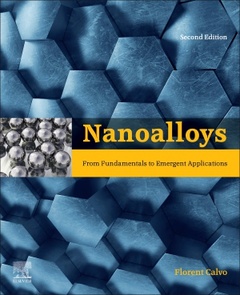Nanoalloys (2nd Ed.) From Fundamentals to Emergent Applications
Coordonnateur : Calvo Florent

2. Transmission Electron Microscopy of Multimetallic Nanoparticles
3. Modeling the electronic and geometric structure of nanoalloys
4. Kinetics of Nanoalloys: Nucleation, Mixing, Coalescence
5. Optical Properties of Metallic Nanoalloys: From Clusters to Nanoparticles
6. Thermodynamical Properties of Nanoalloys
7. A Theoretical Perspective to the Magnetism of Nanoalloys
8. Reactivity and Catalysis by Nanoalloys
9. Nanoalloys for Energy Applications
10. Biomedical Applications of Nanoalloys
11. Toxicity of Colloidal Alloy Nanoparticles
12. Self-assembly of nanoparticles
- Covers fundamentals and applicative aspects of nanoalloys in a balanced presentation, including theoretical and experimental perspectives
- Describes physical and chemical approaches, synthesis and characterization tools
- Illustrates the potential benefit of alloying on various applications ranging from materials science to energy production and nanomedicine
- Updates and adds topics not fully developed at the time of the 1st edition, such as toxicity and energy applications
Date de parution : 06-2020
Ouvrage de 524 p.
19x23.4 cm
Thèmes de Nanoalloys :
Mots-clés :
Ageing; Alloy clusters; Annealing; Bimetallic nanoalloys; Bimetallic nanoparticles; Bioimaging; Biosensor; Cluster geometry; Coalescence; Colloidal; Core–shell nanoparticles; Density functional calculations; Diffusion; Electronic structure; Empirical potentials; Energy conversion; Energy storage; Ethanol oxidation; Exposure scenario; Freezing; Global optimization; Growth; Hyperthermia; Laser ablation; Ligand-protected clusters; Magnetic nanoparticles; Metal oxide nanoparticles; Metallic nanoparticles; Metallic nanoparticles (MNP); Metal-oxide nanoparticles (MOP); Nanoalloy; Nanoalloys; Nanoalloys (NAs); Nanoclusters; Nanostructured surfaces; Nanosystems; Optical response; Oxygen reduction; Photoablation therapy; Polyhedra; Pt nanoparticles; Segregation; Self-assembly; Spectroscopy; Superlattices; Surface dose; Surface plasmon resonance; Targeted drug delivery; Thermodynamics of nonextensive systems; Time-dependent density-functional theory; Toxicity



